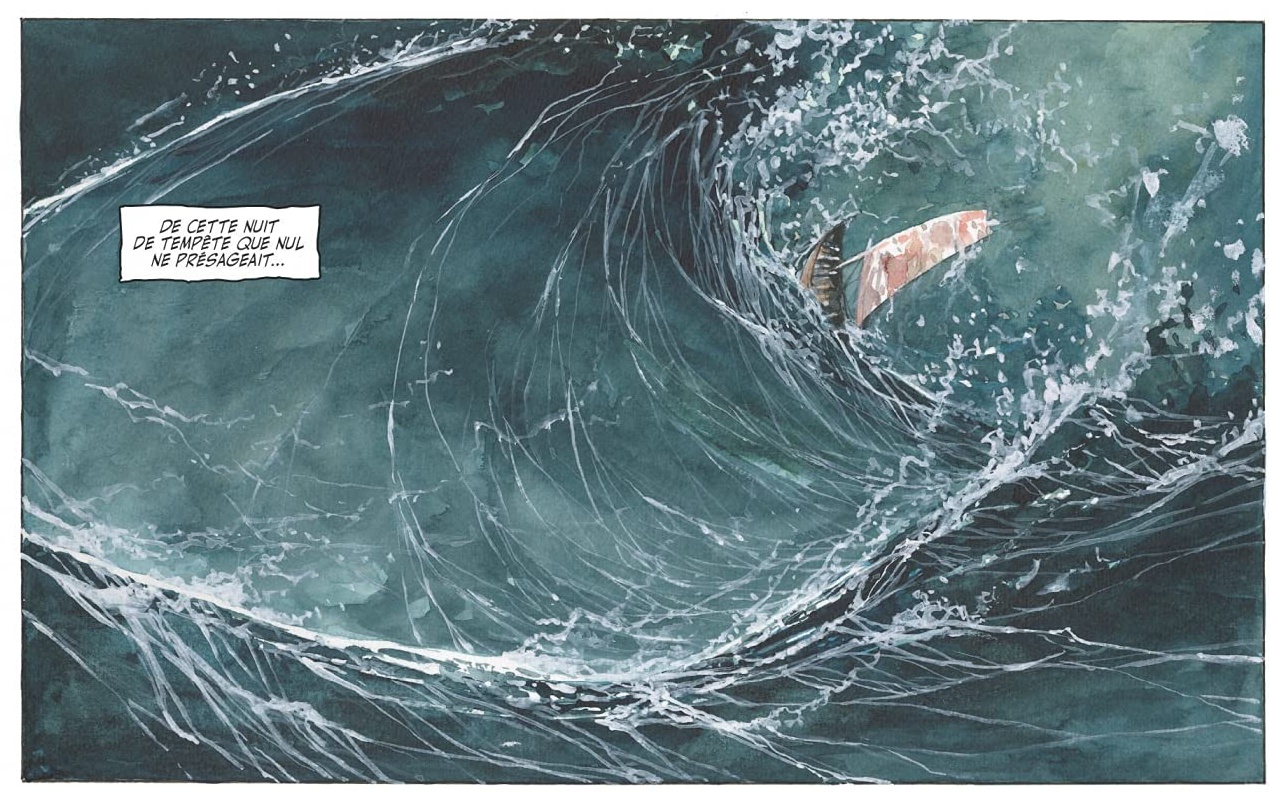While, as every summer, the crowd flocks to the coast, beware of The Girl from the Wharf. If you see her, she will take you with her into death… In any case, according to the tale of Alexine and Fabrice Meddour published by Glénat.
A legend resurfaces
 In thenineteenth century, during a trip, the carriage of a bourgeois is attacked. In the ensuing stampede, the vehicle tipped over into the river. The coachman and the father drown and only the son Haurel survives. He is found by a tribe of gypsies on the edge of the river and it will be necessary to wait for the sequel to The girl of the dock to discover the true cause of the accident. It all comes from a legend circulating in an anonymous village on the coast. A woman would hang out on the docks and all the men meeting her eyes would die. While this legend scares children, adults no longer believe in it. However, at the age of eight, Haurel meets her at a market and becomes in love with her although he is the only one to see her. The other villagers are frightened. The young man and his father must flee the shore urgently to hope to escape and that's when the robbery occurred. To conform to this aquatic legend, Fabrice Meddour opts for a colorization with watercolor but also for tones both solid in a page and very varied according to the pages. Brown dominates and the reader has the impression of reading an aged manuscript. Conversely, drawing has more modern influences. For the faces and layout, we think of Loisel.
In thenineteenth century, during a trip, the carriage of a bourgeois is attacked. In the ensuing stampede, the vehicle tipped over into the river. The coachman and the father drown and only the son Haurel survives. He is found by a tribe of gypsies on the edge of the river and it will be necessary to wait for the sequel to The girl of the dock to discover the true cause of the accident. It all comes from a legend circulating in an anonymous village on the coast. A woman would hang out on the docks and all the men meeting her eyes would die. While this legend scares children, adults no longer believe in it. However, at the age of eight, Haurel meets her at a market and becomes in love with her although he is the only one to see her. The other villagers are frightened. The young man and his father must flee the shore urgently to hope to escape and that's when the robbery occurred. To conform to this aquatic legend, Fabrice Meddour opts for a colorization with watercolor but also for tones both solid in a page and very varied according to the pages. Brown dominates and the reader has the impression of reading an aged manuscript. Conversely, drawing has more modern influences. For the faces and layout, we think of Loisel.
It is also a gothic tale
While the first page gives the illusion of a historical narrative, The Girl on the Wharf is at the intersection of the historical novel and the fantastic. The gypsies who raise Haurel are marginalized from the eighteenth to thenineteenth century because these nomads worry the sedentary peasants. This people is part of European history but it is associated with many legends. The costumes and most of the sets are inspired by theseventeenth century but a city seems to float then Haurel dances on the roof of the houses without ever touching the ground. But this magic is not a gimmick because each surprising event finds an explanation over the pages.  The Girl at the Wharf is also a tale about sexual passion. Humans are metamorphosing under the effect of excitement. A supernatural beauty comes to unite with a man. If these elements of the story may seem very erotic to you, Fabrice Meddour is never vulgar. He chooses to alternate between the suggestion of consensual relationships and the violence of sexual abuse. The screenplay by Alexine and Fabrice Meddour compose a dark tale. Haurel is so enamored that he neglects everything else. He leaves his adopted family and risks losing his life when he meets the girl from the dock. However, his meeting with another woman Ella protects him for a time. She keeps this threat away from the past, but can she save him from this evil appearance all the time? Haurel remains divided between this woman from her past and her current family life. Not only does this girl from the wharf disrupt Haurel's life, but she also ruins the lives of all her loved ones. From his father to his fiancée, all suffer the jealousy of the ghost. The character of Haurel is gradually changed and in the second part, Fabrice Meddour makes the violence squirt disconcerting the reader. La fille du quai is a great success because like a raging ocean, the reader attends a series of waves each unique: historical narrative, erotic images or dark tale follow one another. Without revealing everything, Alexine and Fabrice Meddour compose a total reinterpretation of a mythological creature. You can find on these links other fantastic stories Circe and Charly.
The Girl at the Wharf is also a tale about sexual passion. Humans are metamorphosing under the effect of excitement. A supernatural beauty comes to unite with a man. If these elements of the story may seem very erotic to you, Fabrice Meddour is never vulgar. He chooses to alternate between the suggestion of consensual relationships and the violence of sexual abuse. The screenplay by Alexine and Fabrice Meddour compose a dark tale. Haurel is so enamored that he neglects everything else. He leaves his adopted family and risks losing his life when he meets the girl from the dock. However, his meeting with another woman Ella protects him for a time. She keeps this threat away from the past, but can she save him from this evil appearance all the time? Haurel remains divided between this woman from her past and her current family life. Not only does this girl from the wharf disrupt Haurel's life, but she also ruins the lives of all her loved ones. From his father to his fiancée, all suffer the jealousy of the ghost. The character of Haurel is gradually changed and in the second part, Fabrice Meddour makes the violence squirt disconcerting the reader. La fille du quai is a great success because like a raging ocean, the reader attends a series of waves each unique: historical narrative, erotic images or dark tale follow one another. Without revealing everything, Alexine and Fabrice Meddour compose a total reinterpretation of a mythological creature. You can find on these links other fantastic stories Circe and Charly.















![[Live Report] Rock En Seine 2024 : 20 ans et toujours aussi passionnés !](https://www.justfocus.fr/wp-content/uploads/2024/11/RES24_JOUR01_LANA-DEL-REY_LOUIS-COMAR-12.jpg)




















![#Focus drama : ces drama coréens à ne pas louper en avril 2017 ! [3/3]](https://www.justfocus.fr/wp-content/uploads/2017/04/Mystery-Queen-05.jpg)
